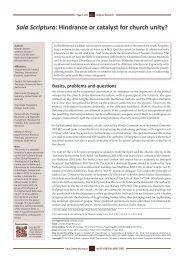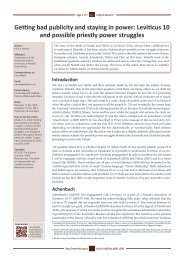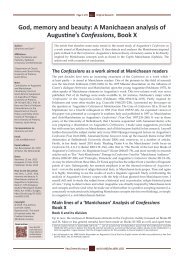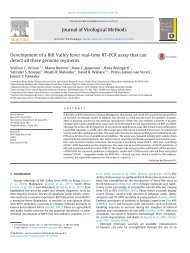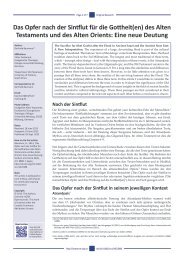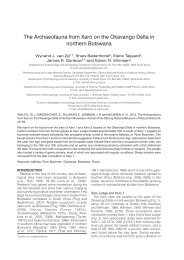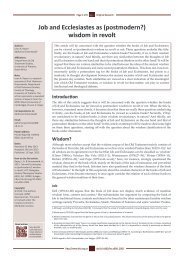View/Open - University of Pretoria
View/Open - University of Pretoria
View/Open - University of Pretoria
Create successful ePaper yourself
Turn your PDF publications into a flip-book with our unique Google optimized e-Paper software.
found that while it provided more detail, the “apparent seepage between categories”<br />
in the construct could be confusing. In addition, Bachman and Palmer (1996:66) point<br />
out that the construct would have to be reinterpreted for each testing situation. Yeld<br />
(2000) has done exactly this in the design <strong>of</strong> the academic literacy test developed at<br />
the Alternative Admissions Research Project (AARP), and it is this construct that Van<br />
Dyk and Weideman (2004) find most useful. Van Dyk and Weideman (2004:10) point<br />
out, however, that while the construct was useful, the AARP test was an admissions<br />
test, was part <strong>of</strong> a larger battery <strong>of</strong> tests, was a two and a half hour test and took more<br />
than three hours to administer. This would not be practical for the academic literacy test<br />
planned for the students at the <strong>University</strong> <strong>of</strong> <strong>Pretoria</strong> (UP). What was needed was a<br />
“reconceptualisation” (Van Dyk & Weideman, 2004:10) <strong>of</strong> how the test was designed.<br />
After much rationalising, re-ordering and reformulating (2004:10), the result was a<br />
“streamlined version” (2004:10) that made possible the testing <strong>of</strong> academic literacy<br />
within a much shorter time frame.<br />
The proposed blueprint for the test <strong>of</strong> academic literacy for the <strong>University</strong> <strong>of</strong> <strong>Pretoria</strong><br />
requires that students should be able to:<br />
• understand a range <strong>of</strong> academic vocabulary in context;<br />
• interpret and use metaphor and idiom, and perceive connotation, word<br />
play and ambiguity;<br />
• understand relations between different parts <strong>of</strong> a text, be aware <strong>of</strong> the<br />
logical development <strong>of</strong> (an academic) text, via introductions to conclusions,<br />
and know how to use language that serves to make the different<br />
parts <strong>of</strong> a text hang together;<br />
• interpret different kinds <strong>of</strong> text type (genre), and show sensitivity for the<br />
meaning that they convey, and the audience that they are aimed at;<br />
• interpret, use and produce information presented in graphic or visual<br />
format;<br />
• make distinctions between essential and non-essential information, fact<br />
and opinion, propositions and arguments; distinguish between cause and<br />
effect, classify, categorise and handle data that make comparisons;<br />
• see sequence and order, do simple numerical estimations and computations<br />
that are relevant to academic information, that allow comparisons to<br />
be made, and can be applied for the purposes <strong>of</strong> an argument;<br />
• know what counts as evidence for an argument, extrapolate from information<br />
by making inferences, and apply the information or its implications to<br />
other cases than the one at hand;<br />
• understand the communicative function <strong>of</strong> various ways <strong>of</strong> expression in<br />
academic language (such as defining, providing examples, arguing); and<br />
185<br />
Journal for Language Teaching | Tydskrif vir Taalonderrig



